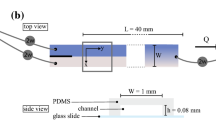Summary
The energy flux carried by diffusing molecules in a binary liquid solution is shown to obey a rate equation linking its time rate of change to energy-exchange and particle-scattering terms and to driving terms proportional to the temperature and concentration gradients. This equation, together with a similar equation for the energy flow carried by high-frequency sound waves, is written in terms of thermodynamic forces which are assumed linear in the two heat flux components, and it is found that these forces may be calculated by interpreting the rate equations as thermodynamic phenomenological relations and then applying Onsager’s theorem and Maxwell’s relations. Prom the forces, one can determine explicitly the dependence of the free energy per moleculeA on the energy flux vectors and, in the limit of low acoustic frequencies, the dependence ofA on the square of the concentration gradient. The low-frequency limits of the rate equations also give an expression for the thermal diffusion coefficient.
Riassunto
Si dimostra che il flusso di energia trasportato dalle molecole che si diffondono in una soluzione liquida binaria obbedisce ad una equazione di relazione che lega la veloeità di variazione col tempo ai termini di cambio di energia e di scattering di particelle ed a termini di guida proporzionali ai gradienti di temperatura e concentrazione. Si scrive questa equazione, ed una equazione analoga per il flusso di energia trasportato da onde sonore di alta frequenza, in funzione delle forze termodinamiche che si presumono lineari nelle due componenti del flusso termico, e si trova che queste forze si possono calcolare interpretando le equazioni di relazione come relazioni termodinamiche Maxwell. Da queste forze si puÒ determinare esplicitamente la dipendenza dell’energia libera per molecola,A, dai vettori del flusso di energia ed, entro i limiti delle basse frequenze acustiche, la dipendenza diA dal quadrato del gradiente di concentrazione. I limiti di bassa frequenza delle equazioni di relazione danno anche un’espressione del coefficiente di diffusione termica.
Similar content being viewed by others
References
R. J. Bearman:Journ. Chem. Phys.,31, 751 (1959).
R. E. Nettleton:Phys. Fluids,4, 74 (1961).
S. R. de Groot:Thermodynamics of Irreversible Processes (Amsterdam, 1951); see Chapter VII.
R. E. Nettleton:Phys. Fluids,3, 216 (1960).
R. E. Nettleton:Journ. Chem. Phys.,33, 237 (1960).
R. E. Nettleton:Phys. Fluids,4, 1488 (1961).
Zwanzig has shown [Phys. Rev.,124, 983 (1961)]
M. Mooney:Trans. Soc. Rheol.,1, 63 (1957).
M. H. Cohen andD. Turnbull:Journ. Chem. Phys.,31, 1164 (1959).
J. Naghizadeh andS. A. Rice:Journ. Chem. Phys.,36, 2710 (1962).
For references and discussion, compareK. F. Herzfeld andT. A. Litovitz Absorption and Dispersion of Ultrasonic Waves (New York, 1959), p. 361 ff.
The diffusion coefficient is defined inJ. O. Hirschfelder,C. F. Curtiss andR. B. Bird:Molecular Theory of Gases and Liquids (New York, 1954), p. 11.
The forces conjugate toq and J2 are given in ref. (3), p. 98.
R. E. Nettleton:Phys. Fluids,5, 687 (1962).
E. W. Hart:Journ. Chem. Phys.,34, 1472 (1961).
Author information
Authors and Affiliations
Rights and permissions
About this article
Cite this article
Nettleton, R.E. Inertial effects in the phenomenological theory of thermal diffusion in liquids. Nuovo Cim 28, 952–969 (1963). https://doi.org/10.1007/BF02782025
Received:
Published:
Issue Date:
DOI: https://doi.org/10.1007/BF02782025




